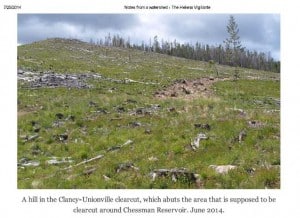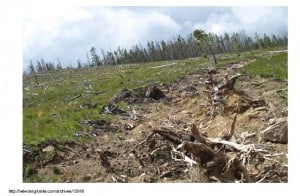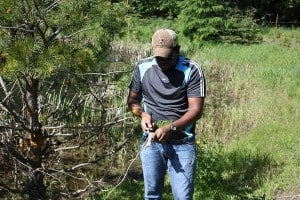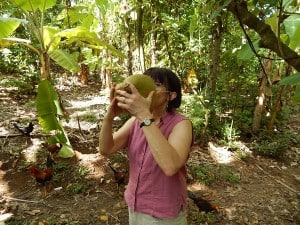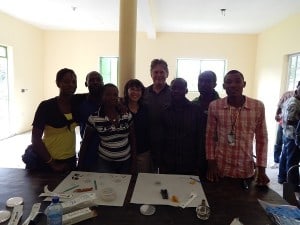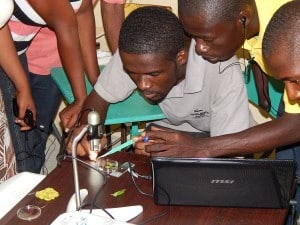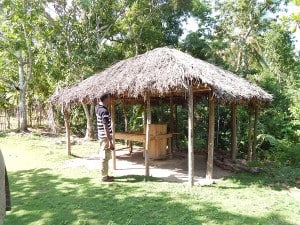The term “precautionary principle” has been kicked around a little here, but here’s another perspective. First, DellaSala’s quote that “With the precautionary principle, the agency has the burden of proof to demonstrate it’s not harmful” is not at all being “sloppy about science”, it’s exactly consistent with how the term is used in legal and policy contexts. The expression “first do no harm” (which comes from the physicians’ Hippocratic oath) is quite different from the precutionary principle. The quote that Jon found regarding “Despite U.S. acceptance of the precautionary principle in international treaties and other statements…” actually sugarcoats U.S. policy on the precautionary principle, especially in the arena where it has been most prominent, which is international regulation of biotechnology. The U.S. actively opposed the precautionary principle there, to the extent that we still are not parties to the Cartagena protocol where it arose.
Down below, though no one asked for it, is an excerpt from a law review article I wrote a couple years ago about the precautionary principle (and other things), in the context of pest control and biotechnology. Lots of good references in the footnotes.
But whether you wade through the article or not, I think it’s interesting how the PP, most commonly expressed as “Where there are threats of serious or irreversible damage, lack of full scientific certainty shall not be used as a reason for postponing cost-effective measures to prevent environmental degradation,” offers perspectives on forest policy. I would note that it’s not necessarily a so-called “enviro” perspective: for example, aggressive forest thinning in the hopes of reducing future risks of wildfires would be a very good example of the PP at work.
A common metaphor for the PP goes something like, if you’re driving down the road and you think the bridge may be out ahead, do you apply the brakes before you know for sure, or do you wait for proof (when it may be too late). The answer seems like common sense, but what if you’re delivering an urgent package and any delay would be very costly? Applying the brakes will cost you money. Then it becomes a value judgement that relates to how you handle risk. I think there are lots of interesting analogies in forest management.
From: Guy R. Knudsen, Where’s the Beef? How Science Informs GMO Regulation and Litigation, 48 IDAHO L. REV. 225 (2012)
full text here: http://gknudsenlaw.com/wp-content/uploads/2012/48IdahoLRev225.pdf
IV. PHILOSOPHICAL DIFFERENCES ON THE INTERNATIONAL FRONT: THE PRECAUTIONARY PRINCIPLE VS. SO-CALLED “SCIENCE-BASED” RISK EVALUATION OF GMOS
International concerns about the transnational movement of the products of biotechnology, and possible adverse effects on biodiversity, were first addressed, although briefly, in the context of the Convention of Biological Diversity (CBD), adopted in Rio de Janeiro in 1992.102 The CBD requires Parties to “[e]stablish or maintain means to regulate, manage or control the risks associated with the use and release of living modified organisms resulting from biotechnology,” which pose the threat of adverse environmental impacts that could affect biological diversity or present risks to human health (the term “living modified organism” (LMO) is essentially synonymous with “GMO,” except that GMO is sometimes used to refer to nonliving bulk commodities of recombinant origin.103 Here, the two terms will be used interchangeably and restrict-ed to living organisms that are released into the environment and which are potentially capable of growth and reproduction).104 The CBD also requires that Parties consider the need and appropriate form of “protocol setting out appropriate procedures, including advance informed agreement, in the field of the safe transfer, handling, and use of any living modified organism resulting from biotechnology that may have ad-verse effect on the conservation and sustainable use of biological diversi-ty.”105
Thus, in the biodiversity protection context, the CBD distinguishes LMOs from other organisms on the basis of their origin in recombinant DNA technology, rather than on any potentially invasive or otherwise harmful characteristics of the organisms themselves. This focus on the recombinant nature of organisms, rather than more generally on their potential for invasiveness or other biodiversity-harmful traits, was carried forward into the Cartagena Protocol, which took effect on Septem-ber 11, 2003.106 The United States has signed, but not ratified the Convention on Biological Diversity, and thus is not a party to the Cartagena Protocol. Nonetheless, the United States played a significant role as an initial advocate of the latter instrument. The Cartagena Protocol’s objec-tive is to facilitate the safe importation and use of LMOs. Organisms that the Cartagena Protocol covers include genetically engineered plants, animals, and microorganisms that cross international borders.107
The primary goal of the Cartagena Protocol is to minimize adverse effects on biodiversity, including possible risks to human health, without unnecessarily disrupting world food trade.108 The Protocol imposes different levels of stringency depending on the intended use of a particu-lar LMO. For those that will be directly used as food or feed or for processing, only a relatively simple information procedure is required.109 For LMOs intended for introduction into the environment of the importing state, the Protocol requires an Advanced Informed Agreement (AIA) prior to the first transboundary movement of the organism. Components of the AIA include notification and an exchange of information between the exporting and importing countries.110
The Cartagena Protocol adheres to the precautionary principle or “precautionary approach” first delineated in the Rio Declaration on En-vironment and Development.111 The most commonly expressed version of the precautionary principle is: “Where there are threats of serious or irreversible damage, lack of full scientific certainty shall not be used as a reason for postponing cost-effective measures to prevent environmental degradation.”112 As applicable to the Cartagena Protocol, the precautionary principle provides that lack of scientific certainty about the extent of potential adverse effects shall not prevent a party, typically the importing State, from deciding not to allow LMO imports. Proponents of this approach included a number of developing nations who expressed fears that “a major loss of biodiversity” could result “from a replacement of traditional farming methods by genetically engineered crops.”113 Their views were echoed by environmental non-governmental organizations present at Cartagena including Greenpeace and the Worldwide Fund for Nature.114
The decision to follow the precautionary approach was conten-tious.115 During the development of the Cartagena Protocol, the U.S., although initially a state sponsor of the process, lobbied unsuccessfully for adoption of a less restrictive “scientific evidence standard,” alternatively known as the “sound scientific knowledge” basis.116 The scientific evidence standard is consistent with that found in the World Trade Organization Agreement on the Application of Sanitary and Phytosanitary Measures; the latter is relevant to alien species characterized as pests or pathogens, to the extent that measures to manage these species affect international trade.117 WTO member states may adopt national measures to protect human, animal, or plant health / life from risks arising from the entry, establishment or spread of pests, diseases, or disease-causing organisms and to “prevent or limit other damage” with-in its territory from these causes.118
The scientific evidence standard essentially requires that confirmed scientific evidence of harm be present prior to banning the import of a LMO. In this effort, the U.S. was joined by a number of other countries (the so-called “Miami Group,” whose other members were Argentina, Australia, Canada, Chile, China, and Uruguay), and was bolstered by support from the U.S. biotech industry. The motivation for the U.S. to first champion, but then abandon, the Cartagena Protocol has been de-bated. Keleman and Vogel pointed out that governments are more likely to support international environmental agreements when those agreements provide advantages to domestic producers in international com-petition, and tend to oppose such agreements when the costs of compliance put domestic firms at a competitive disadvantage.119 From this per-spective, early U.S. enthusiasm for a biotechnology protocol might be viewed as a preemptive attempt to occupy the regulatory field, in which a weak protocol would effectively codify a more laissez-faire approach to international regulation of biotechnology, to the advantage of U.S. producers. However, as a major biotech-exporting country with anti-biotech litigation an ongoing feature in its courts,120 the United States apparent-ly was concerned that inclusion of the precautionary principle as a fun-damental tenet of the Cartagena Protocol could have a chilling effect on exports. Some observers believed that the Miami Group’s strategy was to maintain exports of GMO commodities without the hindrance of in-formation, documentation, or a chance for informed decision-making by importing countries.121 Allegedly, “frustrated delegates from the develop-ing world” were heard to complain that “the negotiations at Cartagena were on ‘Biotrade’ not Biosafety.”122
Arguably, the term “scientific evidence standard” is misleading, since both the precautionary principle and the scientific evidence stand-ard involve risk management approaches in the face of uncertainty, and neither is fundamentally more “scientific” than the other. In one sense, the conflict involves differing approaches to the rate of technological transfer: the position of the United States favors a “rapid rate of technological transfer,” while Europe generally advocates a “slow[er] and [more] cautious rate.”123 These conflicting approaches may also be analyzed in the context of the burdens of proof that they require. The pre-cautionary principle places the burden of proving that GM products do not pose a threat to human health or the environment on the developers of the products,124 whereas the so-called scientific evidence standard places the burden of proving that the GM product presents a significant and quantifiable risk to health or the environment on those opposing the product’s introduction.
Ahteensuu observed that in quantitative risk assessment, which he considered “the prevailing institutionalized risk governance methodology,” conclusive scientific proof has generally been used as the “prerequisite for taking preventative measures.”125 However, in numerous instances there have been early indications of environmental damage be-fore it materialized or fulfilled the strict criteria for scientific acceptance, so that taking no precaution in the state of uncertainty resulted in serious adverse consequences.126 Conversely, the scientific evidence standard places the burden of proof on those who would oppose the in-troduction or deployment of GM crops or other GM organisms. Cranor notes that the scientific tradition (e.g., the use of statistical confidence limits) “strongly and asymmetrically” protects against false positive errors; for example, inferential procedures that show health or environ-mental risks when there are none.127 This standard contrasts with that used in tort law, where the prevailing view is that “legal false positives (i.e., mistakenly deciding for plaintiffs) should be approximately equal to legal false negatives (i.e., mistakenly deciding for defendants).”128
Thus, a cultural gap arises between science and law concerning the standards of proof required within each culture. Uncertainty raises “a substantial barrier for the party with the burden of proof,”129 so that it’s hardly surprising that proponents and opponents of GM crops each lobby for a different evaluation regime. The culture of science is not necessarily helpful at resolving these differences. As Cranor notes, science is open-ended, with even comparatively settled conclusions being open to revision, so that “scientists ordinarily assert their views with considerable uncertainty even [when] their personal beliefs may be stronger.”130
102. United Nations Conference on Environment and Development: Convention on Biological Diversity, opened for signature June 5, 1992, 31 I.L.M. 818.
103. Id. at art. 8(g).
104. Id.
105. Id. at art. 19(3).
106. Cartagena Protocol on Biosafety to the Convention on Biological Diversity, adopted on Jan. 29, 2000, 39 I.L.M. 1027 (entered into force Sept. 11, 2003), http://bch.cbd.int/protocol/text/.
107. Id.
108. See generally id. at arts. 1, 2.
109. Id. at 1031–32.
110. Id. at 1030–33.
111. United Nations Conference on Environment and Development, Rio de Janiero, Braz., June 3–14, 1992, Rio Declaration on Environment and Development, U.N. Doc. A/CONF.151/26 (Vol. I), Annex I, Principle 15 (Aug. 12, 1992).
112. Id.
113. See Lavanya Rajamani, The Cartagena Protocol—A Battle Over Trade or Bi-osafety?, THIRD WORLD NETWORK, http://www.twnside.org.sg/title/lavanya-cn.htm. (last vis-ited on Nov. 3, 2011).
114. Id.
115. See ROSIE COONEY, THE PRECAUTIONARY PRINCIPLE IN BIODIVERSITY CONSERVATION AND NATURAL RESOURCE MANAGEMENT, INT’L UNION FOR CONSERVATION OF NATURE, POLICY AND GLOBAL CHANGE SERIES NO. 2, at 13 (2004), http://data.iucn.org/dbtw-wpd/edocs/PGC-002.pdf.
116. See Rafe Pomerance, The Biosafety Protocol: Cartagena and Beyond, 8 N.Y.U. ENVTL. L. J. 614, 618–20 (2000).
117. The WTO Agreement on the Application of Sanitary and Phytosanitary Measures (SPS Agreement), WORLD TRADE ORG., Article 2(2), http://www.wto.org/english/tratop_e/sps_e/spsagr_e.htm (last visited Oct. 25, 2011); id. at Annex A.
118. Id. at Annex A.
119. R. Daniel Kelemen & David Vogel, Trading Places: The Role of the United States and the European Union in International Environmental Politics, 43 COMP. POL. STUD. 427, 444–50 (2009).
120. See Knudsen, supra note 69, at 5.
121. Rajamani, supra note 107.
122. Id.
123. See Dane Scott, Perspectives on Precaution: The Role of Policymakers in Deal-ing with the Uncertainties of Agricultural Biotechnology, 5 INT’L J. OF GLOBAL ENVTL. ISSUES 10 (2005).
124. Id. at 12, 23–25.
125. Marko Ahteensuu, Defending the Precautionary Principle Against Three Criticisms, 11 TRAMES 366, 378 (2007).
126. EUR. ENV’T AGENCY, LATE LESSONS FROM EARLY WARNINGS: THE PRECAUTIONARY PRINCIPLE 1896–2000 (Poul Harremoës et al. eds., 2001).
127. Carl F. Cranor, Daubert and the Acceptability of Legal Decisions, 5 J. PHIL., SCI., & LAW 1, 2, May 2005, http://www6.miami.edu/ethics/jpsl/archives/all/cranor.pdf.
128. Id. (italics in original).
129. Id.
130. Id. at 2–3.





